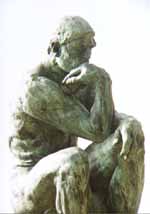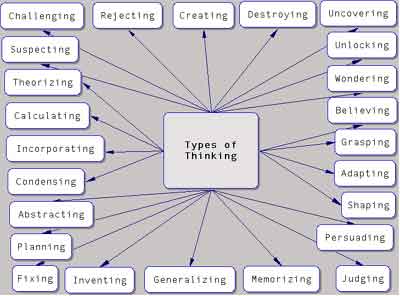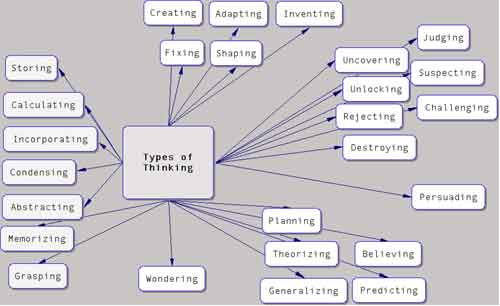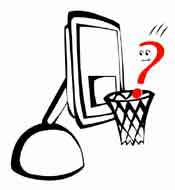| There is plenty of thinking that never achieves lift-off, never contributes to understanding and never casts light on issues of importance. Much thinking beats around the bush, wanders off course and fails to inform or illuminate.
That is because thinking can be done in an unquestioning manner.
Thinking without questioning is like drinking without swallowing.
This book promotes the fusion of powerful questioning with thinking.
We must raise young ones to question, to wonder and to learn.
We will encourage students to become serial questioners committed to pursuing important questions until capable of making sense of their worlds and capable of fashioning smart answers to life’s challenges.

With all the attention paid to thinking and thinking skills by schools, it makes sense to consider how questions and questioning act as generative elements of the larger operation. Questioning is a possibly potent but often neglected component of the rather amorphous concept referred to as thinking.
Unfortunately, much thinking is done in an unquestioning manner. One can think up a storm, sweat at the forehead and cover lots of ground without learning, without understanding and without making any true headway. One can spin wheels and accomplish little more than a cat chasing her own tail round and round.
Thinking is often proclaimed by state and national leaders as a chief goal of schooling, but the brand of thinking that results from these lofty goal statements may fall short of the mark, amounting to what Shakespeare might call “a tale told by an idiot” or what Pink Floyd might call “another brick in the wall.”
Thinking that is guided by intense and strategic questioning is more likely to lift the thinker above hohumdrum levels that produce little of worth or note. Sadly, much of what poses as thought offers little in the way of wisdom or novelty, creativity or imagination. Much thinking amounts to little more than going through the motions, pondering without generating, and considering without concluding or deciding.
Ironically and paradoxically, a person can spend lots of time thinking without actually qualifying as a thinking person.
At its worst, thinking can resemble a cow chewing its cud.
Many voters, for example, would claim they think before voting even though such thought might be fundamentally lacking in logic, evidence or consideration. One can go through the motions of thought without actually weighing issues or matters of import, without chewing into the facts and data that clarify differences in track records and future prospects for action. Failing to explore the essential questions underlying a major decision like voting leaves the individual more dependent upon conjecture, intuition, gut feelings and whimsey, all of which can sometimes masquerade as thought.
Unfortunately, the unquestioning voter is more vulnerable to propaganda and simplistic appeals to fear and prejudice. The demagogue loves the unquestioning voter and the unquestioning citizen because appeals to emotion and fear work well with such audiences.
A student can spend weeks studying an important person from history or literature without actually doing any important thinking, yet it might seem to the casual observer that the student has been thinking long and hard. He or she has turned the pages of many books, highlighted some of the sentences and filled dozens of note cards with key quotations and facts, but in many cases the student is merely collecting factoids with a cut-and-paste strategy that has little to do with significance. This gathering is the consequence of well respected school rituals that elevate hunting and gathering to prominent positions while requiring little questioning.

Joan of Arc
In contrast, a student should be considering important aspects of the person’s life such as these listed at the Biography Maker - an online resource I developed to encourage students to focus on matters of import when studying important people.
Biography Questions
- 1. In what ways was the life remarkable?
2. In what ways was the life despicable?
3. In what ways was the life admirable?
4. What human qualities were most influential in shaping the way this person lived and influenced his or her times?
5. Which quality or trait proved most troubling and difficult?
6. Which quality or trait was most beneficial?
7. Did this person make any major mistakes or bad decisions? If so, what were they and how would you have chosen and acted differently if you were in their shoes?
8. What are the two or three most important lessons you or any other young person might learn from the way this person lived?
9. Some people say you can judge the quality of a person's life by the enemies they make. Do you think this is true of your person's life? Explain why or why not.
10. An older person or mentor is often very important in shaping the lives of gifted people by providing guidance and encouragement. To what extent was this true of your person? Explain.
11. Many people act out of a "code" or a set of beliefs which dictate choices. It may be religion or politics or a personal philosophy. To what extent did your person act by a code or act independently of any set of beliefs? Were there times when the code was challenged and impossible to follow?
12. What do you think it means to be a hero? Was your person a "hero?" Why? Why not? How is a hero different from a celebrity?
-
Unfortunately, thought is easily and frequently held captive by prejudice, preconception, ignorance and closed-mindedness. Some who claim to be thinking are merely turning shopworn ideas and myths over and over again as if turnover had something to do with invention, as if regurgitation had something to do with discovery and insight.
Powerful thought frequently involves boundary breaking, exploration, uncovering, unwrapping and exposure. Breakthrough thinking may engage young ones in questioning authority, challenging conventional wisdom and spawning new beliefs.
- We don’t need no education.
We don’t need no thought control.
“Another Brick in the Wall” by Pink Floyd
Perhaps these uncomfortable aspects of questioning may help to explain some of the wasted time and motion surrounding a thinking curriculum.
When rock musicians create songs about bricks in the wall and mind control, we might dismiss them and their satires as hyperbolic reactions of delinquents and dropouts, but embedded in such songs are some disturbing truths about schooling as training for work on assembly lines and fast food restaurants. Pink Floyd’s lyrics, along with those of Paul Simon, warn of education as regimentation, transmission of culture and indoctrination. They hint darkly that schooling is too often about compliance, submission and conformity.
- When I think back
On all the crap I learned in high school
It’s a wonder
I can think at all
And though my lack of education
Hasn’t hurt me none
I can read the writing on the wall
“Kodachrome” by Paul Simon
Pink Floyd warns that even though they “can read the writing on the wall, it doesn’t mean anything at all. All in all the words are just bricks in the wall.”
Is it possible for a state or nation to promote a thinking curriculum while doing a first rate job of indoctrination all at the same time?
Unfortunately, the answer is affirmative. It is possible to promote thinking without promoting the questioning that infuses the thinking with purpose.
One can learn to think (or color) within the (party) lines.
Mapping Out Zones of Thinking
It may help to clarify the role of questioning as an aspect of thinking to map out the various types and zones of thinking that are included under the broad concept. An appreciation of the dozens of types of thinking and how some end up being little more than cul-de-sacs and diversions will illustrate the central importance of strategic questioning as a way of promoting movement toward understanding.
The first figure shows several dozen types of thinking that appear ungrouped and uncategorized, but a second version of this figure suggests a grouping pattern. Some types of thinking provoke more originality and actual production than others.

The types of thinking lined up on the left side of the diagram below are the ones that require the least amount of questioning. They all share a focus on memorizing and absorbing rather than generating and producing. If we expect our young ones to become thinkers, capable of developing ideas and insights instead of merely copying and pasting the thinking or the ideas of others, then questioning becomes paramount, and the importance of the right side of the diagram becomes evident.

Some schools have devoted too much time to the left side, all the while purporting to be teaching thinking. This book is devoted to the proposition that the types of thinking listed on the right side are critically important in a healthy democracy and a vibrant society.
The Difference Between Learning and Absorbing
Some confuse absorption with learning, as if students were sponges soaking up the accumulated wisdom, facts and understandings of the elders. Many curriculum documents provide lengthy lists of concepts and information students should absorb - soak up - at various levels. If one absorbs, does one also understand?
Many definitions of learning and teaching seem focused, sadly, on this sponge metaphor. It is as if one learns something by digesting it, by reading it, by hearing it and by committing it to memory.
In many cases, sadly, classroom learning is akin to shelving stock in a warehouse - just another brick in the wall. It is about accumulating information.
Unfortunately, despite all the talk and the writing about a thinking curriculum, it may be that some do not expect students to become real thinkers - those who are capable of fresh thought.
Fresh thought requires that one cope with dissonance, with confusion and with uncertainty. The thinker must fashion new understandings instead of accepting and memorizing the ideas of others. Cutting and pasting is not sufficient.
The Difference Between Teaching and Learning
It seems as if some schools are too focused on teaching and instruction instead of learning. These are schools that keep putting more bricks in the wall. While some might complain that these are merely matters of semantics, the words carry with them powerful and controlling implications.
Teaching and instruction tend to focus on the actions of the teacher transmitting and conveying content to students. A school committed to student learning, on the other hand, would focus more energy on how teachers are orchestrating the questioning, thinking and discovery of students so they might come up with their own ideas.
In the first school, the teacher might explain the magic of a particular poem and poet to a class, expecting that the students would take careful notes. In the second school, the students might look at the poems and argue over the degree of magic to be found.
While the above sketch is a huge oversimplification of what actually occurs, it does capture a crucial educational divide that usually goes unmentioned.
A few years back I watched three different teachers working with classes in the Louvre.

In the first group, a teacher spoke rapidly and energetically about a painting while her 15 year old students wrote down her every word. Even though the painting was hanging right there in front of them, the girls were so busy scribbling they had no time to look at the painting. They had learned, I suppose, that capturing the teacher’s words were the secret to scoring well on art appreciation.
In contrast, the neighboring group of 15 year old girls were gazing at a painting spellbound. Neither they nor their teacher did much speaking or writing. The teacher dangled a question and let it hang suspended.
“What questions come to mind as you consider this painting?”
The girls stare intently. Here and there a student scribbles briefly on a note pad then returns to staring.
“Shouldn’t we be thinking about his choice of color and his use of light?” asks one girl.
A half dozen girls nod their heads in agreement as the teacher smiles her approval.
“Certainly,” she says. “That makes sense to me. What else?”
And a third group across the room listens with full attention as an attractive and charismatic guide speaks enthusiastically in front of a huge battle scene.
This class is made up of senior citizens who do not bother to take notes but hang on each word of their guide as if she is the leading world authority on this artist. With the personal appeal of a movie star, she casts a magic light on the painting before them. They have the luxury of feeling rapture while learning, comfortable with the knowledge that there will be no test and the morning will end with a wonderful meal at a bistro accompanied by good red wine.
Questioning as Yeast
Questioning is to thinking as yeast is to bread making. Unleavened bread is flat, hard and unyielding. Unleavened thinking is uninspired.
Questioning is what converts the “stuff” of thinking into something of value, acting as leaven to transform matter into meaning.
- leaven (NOUN)
An agent that stimulates or precipitates a reaction, development, or change: catalyst, ferment, leavening, yeast. See CHANGE.
Roget’s II: The New Thesaurus, Third Edition. 1995.
The power of this metaphor can be visualized when tracking the relationship between “leaven” and associated terms such as “raise” and “elevate” as shown in the cluster diagram below produced by the Visual Thesaurus at http://www.visualthesaurus.com. (Permission to include image is being sought. You can see it by going to the site and entering "elevate" as the term.)
Note especially, terms such as kindle, elicit, provoke, conjure up, nurture and produce. If only we could raise students capable of such thinking!
At the same time, questioning may act like kneading the dough or forming it into loaves. The main point here is the importance of lifting thinking beyond the mundane.
The consequences of promoting thinking without due attention to questioning are evident when considering the terms associated with the word “flat” as shown in the diagram on this page produced using the Visual Thesaurus. (Permission to include image is being sought. You can see it by going to the site and entering "flat" as the term.)
Words like insipid, fixed, unqualified, regressive, underdeveloped and dull stand out and serve as a warning that not all thinking proves worthy or worthwhile.
Inattention to questioning condemns the young to collecting, cutting and pasting and servile compliance.
Nurturing a dynamic relationship between questions, wonder and curiosity, on the other hand, frees the young to invent, produce, contribute and adjust to a turbulent and changing world.
|
 The Question Mark
The Question Mark 





